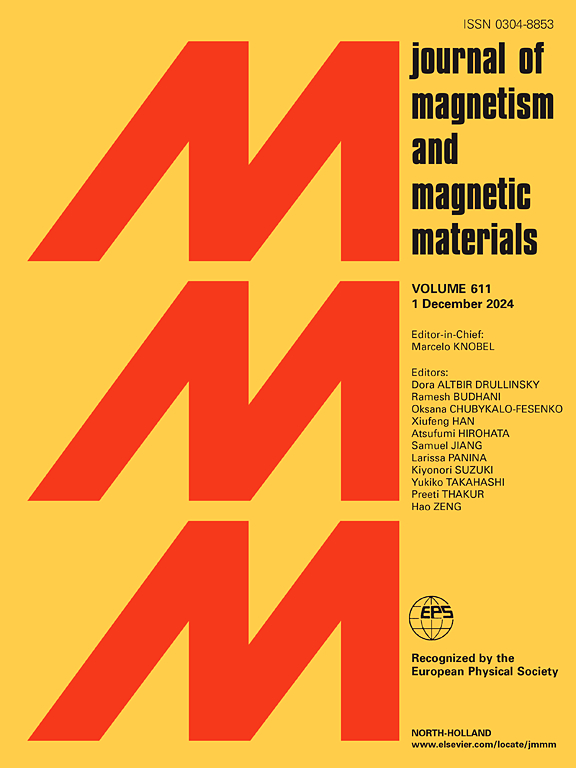Influence of demagnetizing effect on the shape and broadening of magnetoresistance curves
IF 2.5
3区 材料科学
Q3 MATERIALS SCIENCE, MULTIDISCIPLINARY
引用次数: 0
Abstract
It was observed in recent magnetoresistance studies on elongated strip-shaped thin foil samples that the MR(H) hysteresis curves have different shapes and widths in the longitudinal (L) configuration (field H parallel with the measuring current) and in the transverse (T) configuration (field H transverse to the measuring current). Subsequent magnetic measurements [L.F. Kiss et al., Eur. Phys. J Plus 139, 844 (2024)] of similar strip-shaped samples taken with different field orientations (corresponding either to the LMR or TMR configurations of the magnetoresistance measurements) revealed differences also in the M(H) magnetization curves, which are attributed to demagnetizing effects. After correcting for the demagnetizing field, the transverse M(H) curves could be brought in fairly good overlap with the measured longitudinal M(H) curves. In the present work, results of MR(H) measurements are reported on strips of the same Ni-Co alloys and pure Ni metal which were used in the M(H) study. Based on this recent work on the M(H) curves, one can now explain the differences in the shape and width of the LMR(H) and TMR(H) curves of a given material in a fully quantitative manner by taking into account the demagnetizing effects. Similarly to the transverse M(H) curves, the TMR(H) curves could also be corrected for the demagnetizing field, yielding good agreement with the LMR(H) curves. Furthermore, whereas the LMR(H) curves exhibited a normal hysteresis corresponding to the hysteresis behavior of the M(H) curve, the TMR(H) curves showed an anomalous behavior which can also be ascribed to demagnetizing effects. The same holds true also for the polar magnetoresistance curves PMR(H) measured in a magnetic field perpendicular to the strip plane.
退磁效应对磁阻曲线形状和展宽的影响
在最近对细长条形薄片样品的磁阻研究中发现,纵向(L)结构(磁场H平行于测量电流)和横向(T)结构(磁场H横向于测量电流)的磁滞曲线具有不同的形状和宽度。随后的磁测量[L.F.]Kiss等人,Eur。理论物理。J + 139,844(2024)]采用不同磁场取向(对应磁电阻测量的LMR或TMR配置)的类似条形样品也显示了M(H)磁化曲线的差异,这归因于退磁效应。经退磁校正后,横向M(H)曲线与实测纵向M(H)曲线有较好的重合。在本工作中,报告了在M(H)研究中使用的相同的Ni- co合金和纯Ni金属带的MR(H)测量结果。基于最近对M(H)曲线的研究,人们现在可以通过考虑退磁效应,以完全定量的方式解释给定材料的LMR(H)和TMR(H)曲线的形状和宽度的差异。与横向M(H)曲线类似,TMR(H)曲线也可以根据退磁场进行校正,与LMR(H)曲线吻合良好。此外,LMR(H)曲线表现出与M(H)曲线对应的正常迟滞行为,而TMR(H)曲线表现出异常行为,这也可归因于退磁效应。在垂直于条带平面的磁场中测量的极磁电阻曲线PMR(H)也是如此。
本文章由计算机程序翻译,如有差异,请以英文原文为准。
求助全文
约1分钟内获得全文
求助全文
来源期刊

Journal of Magnetism and Magnetic Materials
物理-材料科学:综合
CiteScore
5.30
自引率
11.10%
发文量
1149
审稿时长
59 days
期刊介绍:
The Journal of Magnetism and Magnetic Materials provides an important forum for the disclosure and discussion of original contributions covering the whole spectrum of topics, from basic magnetism to the technology and applications of magnetic materials. The journal encourages greater interaction between the basic and applied sub-disciplines of magnetism with comprehensive review articles, in addition to full-length contributions. In addition, other categories of contributions are welcome, including Critical Focused issues, Current Perspectives and Outreach to the General Public.
Main Categories:
Full-length articles:
Technically original research documents that report results of value to the communities that comprise the journal audience. The link between chemical, structural and microstructural properties on the one hand and magnetic properties on the other hand are encouraged.
In addition to general topics covering all areas of magnetism and magnetic materials, the full-length articles also include three sub-sections, focusing on Nanomagnetism, Spintronics and Applications.
The sub-section on Nanomagnetism contains articles on magnetic nanoparticles, nanowires, thin films, 2D materials and other nanoscale magnetic materials and their applications.
The sub-section on Spintronics contains articles on magnetoresistance, magnetoimpedance, magneto-optical phenomena, Micro-Electro-Mechanical Systems (MEMS), and other topics related to spin current control and magneto-transport phenomena. The sub-section on Applications display papers that focus on applications of magnetic materials. The applications need to show a connection to magnetism.
Review articles:
Review articles organize, clarify, and summarize existing major works in the areas covered by the Journal and provide comprehensive citations to the full spectrum of relevant literature.
 求助内容:
求助内容: 应助结果提醒方式:
应助结果提醒方式:


